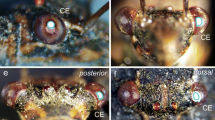Summary
As revealed by glyoxylic acid induced fluorescence, the protandric polychaeteOphryotrocha puerilis possesses different types of catecholaminergic primary bipolar sensory cells, the perikarya of which are located beneath the epidermis. About 20 of such receptors are situated in each segment but they are mostly found on antennae, palps, urites and parapodial cirri. The dendrites of these sensory neurones run to the cuticle and dilate to form receptive endings. Three different types of dendritic endings could be distinguished: (1) multiciliary receptors with 4–8 cilia and ciliary rootlets, (2) monociliary receptors with microvilli arranged like a funnel and electron-dense cuffs and (3) monociliary receptors of the collar-type with, constantly, ten microvilli surrounding one single central cilium. The latter type is also characterized by rootlet fragments. Dendrites and dilated receptive endings of all three types contain clear (putative secretory) vesicles, multivesicular bodies and mitochondria. Pharmacological treatment (dopamine, reserpine) does not affect the number of secretory vesicles of the receptor neurones. Extra vesicular storage of catecholamines is discussed. Secretory cells of unknown function containing large numbers of electron-dense vesicles are usually found in close association with sensory cells.
Similar content being viewed by others
Abbreviations
- CA :
-
catecholamines
- DA :
-
dopamine
- RE :
-
reserpine
References
Cantell C-E, Franzen A, Sensenbaugh T (1982) Ultrastructure of multiciliated collar cells in the pilidium larva ofLinens bilineatus (Nemertini). Zoomorphology 101:1–15
Dietzel ID, Gottmann K (1988) Development of dopamine-containing neurons and dopamine uptake in embryos ofHirudo medicinalis. Dev Biol 128:277–283
Ehlers U (1977) Vergleichende Untersuchungen über Collar-Rezeptoren bei Turbellarien. Acta Zool Fenn 154:137–148
Ehlers U, Ehlers B (1977) Monociliary receptors in interstitial Proseriata and Neorhabdocoela (Turbellaria, Neoophora). Zoomorphology 86:197–222
Elofsson R, Falck B, Lindvall O, Myrberg H (1977) Evidence for new catecholamines of related amino acids in some invertebrate sensory neurons. Cell Tissue Res 182:525–536
Horridge GA (1969) Statocysts of medusae and evolution of stereocilia. Tissue Cell 1:341–353
Jouin C, Tchernigovtzeff C, Baucher M, Toulmond A (1985) Fine structure of probable mechano- and chemoreceptors in the caudal epidermis of the lugwormArenicola marina (Annelida, Polychaeta). Zoomorphology 105:76–82
Mattern CF, Park HD, Daniel WA (1965) Electron microscope observations on the structure and discharge of the stenotele ofHydra. J Cell Biol 27:621–638
Mill JP (1982) Recent developments in earthworm neurobiology. Comp Biochem Physiol 73 A:641–661
Moritz K, Storch V (1971) Elektronenmikroskopische Untersuchung eines Mechanorezeptors von Evertebraten (Priapuliden, Oligochaeten). Z Zellforsch 117:226–234
Nørrevang A, Wingstrand KG (1970) On the occurrence and structure of choanocyte-like cells in some echinoderms. Acta Zool (Stockholm) 51:249–270
Pfannenstiel HD (1973) Zur sexuellen Differenzierung vonOphryotrocha puerilis (Polychaeta, Eunicidae). Mar Biol 20:245–258
Reisinger E (1936) Zur Exkretionsphysiologie vonOphryotrocha puerilis Claparède und Metschnikoff. Thalassia 2:2–24
Reisinger E (1970) Zur Problematik der Evolution der Coelomaten. Z Zool Syst Evolutionsforsch 8:81–109
Rhode B (1986) Vergleichende Untersuchung der Kopfsinnesorgane mariner Anneliden mit verschiedenen Lebens- und Ernährungsweisen. Dissertation, University of Hamburg, Germany
Rhode B (1989) Ultrastructural investigations on the nuchal organ of the protandric polychaete,Ophryotrocha puerilis (Polychaeta, Dorvilleidae). Zoomorphology 108:315–322
Rhode B (1990) Ultrastructure of nuchal organs in some marine polychaetes. J Morphol 205:95–107
Schlawny A, Hamann Th, Müller MA, Pfannenstiel HD (1991) The catecholaminergic system of an annelid,Ophryotrocha puerilis (Polychaeta). Cell Tissue Res (in press)
Slautterback DB (1967) The cnidoblast-musculoepithelial cell complex in the tentacles ofHydra. Z Zellforsch 79:296–318
Sopott-Ehlers B (1984) Epidermale Collar-Receptoren der Nematoplanidae und Polystyliphoridae (Plathelminthes, Unguiphora). Zoomorphology 104:226–230
Storch V (1972) Elektronenmikroskopische Untersuchungen an Rezeptoren von Anneliden (Polychaeta, Oligochaeta). Z Mikrosk Anat Forsch 85:55–84
Storch V, Schlötzer-Schrehardt U (1988) Sensory structures. Microfauna Marina 4:121–133
Voorn P, Buijs R (1988) Ultrastructural demonstration of dopamine in the central nervous system. In: Steinbusch HWM (ed) Monoaminergic neurons: Light microscopy and ultrastructure. Wiley, Chichester, pp 241–264
Windoffer R, Westheide W (1988) The nervous system of the maleDinophilus gyrociliatus (Annelida: Polychaeta). I. Number, types and distribution pattern of sensory cells. Acta Zool (Stockholm) 69:55–64
Author information
Authors and Affiliations
Rights and permissions
About this article
Cite this article
Schlawny, A., Grünig, C. & Pfannenstiel, H.D. Sensory and secretory cells ofOphryotrocha puerilis (Polychaeta). Zoomorphology 110, 209–215 (1991). https://doi.org/10.1007/BF01633005
Received:
Issue Date:
DOI: https://doi.org/10.1007/BF01633005




